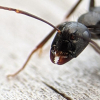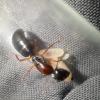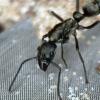Do you tend to have better luck in formicariums where they dig it themselves?
Edited by Works4TheGood, August 14 2015 - 2:25 AM.

Edited by Works4TheGood, August 14 2015 - 2:25 AM.
I purposely made it 3/4 of an inch. This is because over time, the ants sometimes widen their tunnels and chambers until they reach both sides. A lot of ants make pancake-shaped chambers which would easily reach both sides. This also gives them a lot more space, thus making the formicarium last a lot longer.
I just started using these "dirt boxes" this year, but so far it seems that most of the colonies I have in them are doing really well.
Update 8-31-2015
All of Retroman's new queens died, so I gave one of these back to him.
All of mine living in the small dirt boxes died except the original queen that lost all her workers. Right now she has a few larvae that are getting close to pupating, one of which belonged to one of the new deceased queens. Since she has no boost workers now, it will be interesting to see if it was them, or if it was her that was killing the brood every time they were getting close to eclosing.
As for the "colony" in the 10 gallon tank, I finally saw the dealate in a little chamber with a pile of eggs. For a while I still wasn't sure what happened to the alate, until just the other day I saw the alate in the same chamber with the pile of eggs. Retroman's killed each other, so I hope mine don't do the same. I'm not sure if the eggs I'm seeing are always the same pile of eggs, but they don't seem to be developing.
Update 9-10-2015
The original queen has one pupae now. I don't know what happened to the other large larvae she had though.
The new queen or queens in the 10 gallon tank have a whole bunch of larvae now, so one or both of them are probably fertile. ![]()
Update 9-17-2015
The original queen has now eaten its pupae, and has all new small larvae again.
As for the 10 gallon tank colony, I found the winged queen dead outside the nest. I have spotted some large larvae and one pupae, but have only seen workers with them; I have not seen the other dealate queen.
Update 10-5-2015
The "colony" in the 10 gallon tank is obviously dead now. I found a few more dead workers (queens sisters) on the surface, and I have not seen any signs of life in there for two weeks. Before I would always see them in there, sometimes with larvae. I tapped on the glass all over for a while and didn't see any movement. Since this formicarium would work great for Pogonomyrmex rugosus, I moved my colony of P. rugosus into it.
The lone queen in the dirt box is still alive and continues to eat her brood.
Poking a semi deep hole does encourages a starting point for the ants I currently retain thus far every one has used the deep depression to dig down and start the nest.
Current Colonies;
Acromyrmex Versicolor
Dorymyrmex Bicolor
Pogonomyrmex Californicus
Pogonomyrmex Rugosus
Pogonomyrmex Tenuispinus
Novomessor Cockerelli
Myrmecocystus Mexicanus
Last Update: 08 Jul 2016
I thought I once read somewhere in some children's ant-farm instructions that poking a hole down into the substrate helps to encourage the ants to dig there. Maybe you did that without saying, or perhaps it's not even true, but I thought I'd at least throw that ides out there.
It's true, I'm just not sure what you are referring to.
For the lone queen, consider feed her with some honey or protein food (like brood from species) or brood boost?
Update 10-24-2015
Right now the queen in the dirt box has a new pile of eggs, and possibly a few very small larvae. I took ten Pogonomyrmex californicus pupae and waited for them to start eclosing, which happened yesterday, and then I poured them in with her. I did this to make sure she didn't destroy them before eclosing. Now I'm hoping that with all of these boost workers, it might be possible for her brood to fully develop without being eaten by her, now that I am positive she was the one eating the brood every time, and not the P. californicus workers. She seems to have no problem producing; she just keeps keeps killing her offspring.
Update 1-19-2016
The queen continued to eat her brood despite the P. californicus workers. Now it appears she finally died. Hopefully I'll find some of these queens this next season.
Update 9-5-2016
Well this was the worst anting season I have ever seen. Luckily Retroman managed to find a few female alates and two males. He tried breading them and might have gotten two of the females fertilized. He gave them to me to try raising. Until I get a larger setup made for them, I just put them both in two of my small "dirt boxes".
I have a feeling we may be missing something with this species.
Oh, not sure if you've talked to him lately, but one of the queens he bread last year has a pretty big colony now. So he's doing something right.
Been a while, glad to hear that one took.
Edited by gcsnelling, September 6 2016 - 2:29 AM.
I put a reptile heating pad under one side of the enclosure while continuing to provide an overhead lamp. The pad was on 24/7 and the lamp was on a timer for 10 hours/day. They raised a ton of brood in the chambers immediately above the heating pad.
I don't think this species can tolerate life for very long in a test tube or other small environment. They need relatively high temps (circa 32 degrees C, possibly higher) and low humidity to incubate their eggs and for pupal development and simultaneous lower temps and higher humidity for larval growth. This is just not possible in a small environment.
As we know, they have evolved in a hot desert with a very rocky substrate. This substrate conducts heat down into the nest and provides areas that have higher humidity necessary for larval development. Give them a large enclosure, provide a wide temperature and humidity gradient and they can thrive.
Edited by Retroman, September 8 2016 - 5:01 AM.
As Retroman says, heat is definitely a key factor to success with this species.
Edited by gcsnelling, September 9 2016 - 5:40 PM.
Another factor might be that this species is less stress-tolerant of captivity, especially of very restricted environments.
 |
Ant Keeping →
Ant Keeping Journals →
cooIboyJ's Nylanderia vividula journalStarted by cooIboyJ , Sep 6 2025 |
|

|
|
Ant Keeping →
Ant Keeping Journals →
Ants_Dakota's Camponotus sp. JournalStarted by Ants_Dakota , Jul 13 2025 |
|

|
||
Ant Keeping →
Ant Keeping Journals →
Strickys Formica JournalStarted by stricky_ants , Jun 21 2025 |
|

|
||
Ant Keeping →
Ant Keeping Journals →
AntTx's Camponotus sansabeanus JournalStarted by AntsTx , Jun 17 2025 |
|

|
||
Ant Keeping →
Ant Keeping Journals →
The Bark Battalion (Liometopum occidentale)Started by AntsGodzilla , Jun 3 2025 |
|

|
0 members, 1 guests, 0 anonymous users